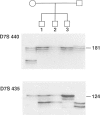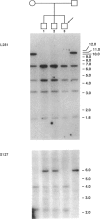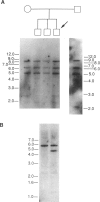Abstract
Uniparental disomy for chromosome 7 has been described previously in two individuals with cystic fibrosis. Here, we describe a third case that was discovered because the proband was homozygous for a mutation in the COL1A2 gene for type I procollagen, although his mother was heterozygous and his father did not have the mutation. Phenotypically, the proband was similar to the two previously reported cases with uniparental disomy for chromosome 7, in that he was short in stature and growth retarded. Paternity was assessed with five polymorphic markers. Chromosome 7 inheritance in the proband was analyzed using 12 polymorphic markers distributed along the entire chromosome. Similar analysis of the proband's two brothers established the phase of the alleles at the various loci, assuming minimal recombination. The proband inherited only maternal alleles at five loci and was homozygous at all loci examined, except one. He was heterozygous for an RFLP at the IGBP-1 locus at 7p13-p12. The results suggest that the isodisomy was not complete because of a recombination event involving the proximal short arms of two maternal chromosomes. In addition, the phenotype of proportional dwarfism in the proband suggests imprinting of one or more growth-related genes on chromosome 7.
Full text
PDF









Images in this article
Selected References
These references are in PubMed. This may not be the complete list of references from this article.
- Alitalo T., Kontula K., Koistinen R., Aalto-Setälä K., Julkunen M., Jänne O. A., Seppälä M., de la Chapelle A. The gene encoding human low-molecular weight insulin-like growth-factor binding protein (IGF-BP25): regional localization to 7p12-p13 and description of a DNA polymorphism. Hum Genet. 1989 Nov;83(4):335–338. doi: 10.1007/BF00291377. [DOI] [PubMed] [Google Scholar]
- Barker D., Green P., Knowlton R., Schumm J., Lander E., Oliphant A., Willard H., Akots G., Brown V., Gravius T. Genetic linkage map of human chromosome 7 with 63 DNA markers. Proc Natl Acad Sci U S A. 1987 Nov;84(22):8006–8010. doi: 10.1073/pnas.84.22.8006. [DOI] [PMC free article] [PubMed] [Google Scholar]
- Barlow D. P., Stöger R., Herrmann B. G., Saito K., Schweifer N. The mouse insulin-like growth factor type-2 receptor is imprinted and closely linked to the Tme locus. Nature. 1991 Jan 3;349(6304):84–87. doi: 10.1038/349084a0. [DOI] [PubMed] [Google Scholar]
- Brewer M. T., Stetler G. L., Squires C. H., Thompson R. C., Busby W. H., Clemmons D. R. Cloning, characterization, and expression of a human insulin-like growth factor binding protein. Biochem Biophys Res Commun. 1988 May 16;152(3):1289–1297. doi: 10.1016/s0006-291x(88)80425-x. [DOI] [PubMed] [Google Scholar]
- Byers P. H., Wallis G. A., Willing M. C. Osteogenesis imperfecta: translation of mutation to phenotype. J Med Genet. 1991 Jul;28(7):433–442. doi: 10.1136/jmg.28.7.433. [DOI] [PMC free article] [PubMed] [Google Scholar]
- Cattanach B. M., Beechey C. V. Autosomal and X-chromosome imprinting. Dev Suppl. 1990:63–72. [PubMed] [Google Scholar]
- Cattanach B. M., Kirk M. Differential activity of maternally and paternally derived chromosome regions in mice. Nature. 1985 Jun 6;315(6019):496–498. doi: 10.1038/315496a0. [DOI] [PubMed] [Google Scholar]
- Chi D. D., Hing A. V., Helms C., Steinbrueck T., Mishra S. K., Donis-Keller H. Two chromosome 7 dinucleotide repeat polymorphisms at gene loci epidermal growth factor receptor (EGFR) and pro alpha 2 (I) collagen (COL1A2). Hum Mol Genet. 1992 May;1(2):135–135. doi: 10.1093/hmg/1.2.135. [DOI] [PubMed] [Google Scholar]
- DeChiara T. M., Robertson E. J., Efstratiadis A. Parental imprinting of the mouse insulin-like growth factor II gene. Cell. 1991 Feb 22;64(4):849–859. doi: 10.1016/0092-8674(91)90513-x. [DOI] [PubMed] [Google Scholar]
- Dean M., Drumm M. L., Stewart C., Gerrard B., Perry A., Hidaka N., Cole J. L., Collins F. S., Iannuzzi M. C. Approaches to localizing disease genes as applied to cystic fibrosis. Nucleic Acids Res. 1990 Jan 25;18(2):345–350. doi: 10.1093/nar/18.2.345. [DOI] [PMC free article] [PubMed] [Google Scholar]
- Donis-Keller H., Green P., Helms C., Cartinhour S., Weiffenbach B., Stephens K., Keith T. P., Bowden D. W., Smith D. R., Lander E. S. A genetic linkage map of the human genome. Cell. 1987 Oct 23;51(2):319–337. doi: 10.1016/0092-8674(87)90158-9. [DOI] [PubMed] [Google Scholar]
- Ehrenborg E., Larsson C., Stern I., Janson M., Powell D. R., Luthman H. Contiguous localization of the genes encoding human insulin-like growth factor binding proteins 1 (IGBP1) and 3 (IGBP3) on chromosome 7. Genomics. 1992 Mar;12(3):497–502. doi: 10.1016/0888-7543(92)90440-4. [DOI] [PubMed] [Google Scholar]
- Ekstrand J., Ehrenborg E., Stern I., Stellan B., Zech L., Luthman H. The gene for insulin-like growth factor-binding protein-1 is localized to human chromosomal region 7p14-p12. Genomics. 1990 Mar;6(3):413–418. doi: 10.1016/0888-7543(90)90470-f. [DOI] [PubMed] [Google Scholar]
- Engel E. A new genetic concept: uniparental disomy and its potential effect, isodisomy. Am J Med Genet. 1980;6(2):137–143. doi: 10.1002/ajmg.1320060207. [DOI] [PubMed] [Google Scholar]
- Engel E., DeLozier-Blanchet C. D. Uniparental disomy, isodisomy, and imprinting: probable effects in man and strategies for their detection. Am J Med Genet. 1991 Sep 15;40(4):432–439. doi: 10.1002/ajmg.1320400411. [DOI] [PubMed] [Google Scholar]
- Fazio M. J., Mattei M. G., Passage E., Chu M. L., Black D., Solomon E., Davidson J. M., Uitto J. Human elastin gene: new evidence for localization to the long arm of chromosome 7. Am J Hum Genet. 1991 Apr;48(4):696–703. [PMC free article] [PubMed] [Google Scholar]
- Julkunen M., Koistinen R., Aalto-Setälä K., Seppälä M., Jänne O. A., Kontula K. Primary structure of human insulin-like growth factor-binding protein/placental protein 12 and tissue-specific expression of its mRNA. FEBS Lett. 1988 Aug 29;236(2):295–302. doi: 10.1016/0014-5793(88)80041-3. [DOI] [PubMed] [Google Scholar]
- Kirkels V. G., Hustinx T. W., Scheres J. M. Habitual abortion and translocation (22q;22q): unexpected transmission from a mother to her phenotypically normal daughter. Clin Genet. 1980 Dec;18(6):456–461. doi: 10.1111/j.1399-0004.1980.tb01794.x. [DOI] [PubMed] [Google Scholar]
- Kontusaari S., Tromp G., Kuivaniemi H., Romanic A. M., Prockop D. J. A mutation in the gene for type III procollagen (COL3A1) in a family with aortic aneurysms. J Clin Invest. 1990 Nov;86(5):1465–1473. doi: 10.1172/JCI114863. [DOI] [PMC free article] [PubMed] [Google Scholar]
- Kuivaniemi H., Tromp G., Prockop D. J. Mutations in collagen genes: causes of rare and some common diseases in humans. FASEB J. 1991 Apr;5(7):2052–2060. doi: 10.1096/fasebj.5.7.2010058. [DOI] [PubMed] [Google Scholar]
- Lathrop G. M., O'Connell P., Leppert M., Nakamura Y., Farrall M., Tsui L. C., Lalouel J. M., White R. Twenty-five loci form a continuous linkage map of markers for human chromosome 7. Genomics. 1989 Nov;5(4):866–873. doi: 10.1016/0888-7543(89)90128-6. [DOI] [PubMed] [Google Scholar]
- Litt M., White R. L. A highly polymorphic locus in human DNA revealed by cosmid-derived probes. Proc Natl Acad Sci U S A. 1985 Sep;82(18):6206–6210. doi: 10.1073/pnas.82.18.6206. [DOI] [PMC free article] [PubMed] [Google Scholar]
- Malcolm S., Clayton-Smith J., Nichols M., Robb S., Webb T., Armour J. A., Jeffreys A. J., Pembrey M. E. Uniparental paternal disomy in Angelman's syndrome. Lancet. 1991 Mar 23;337(8743):694–697. doi: 10.1016/0140-6736(91)90278-w. [DOI] [PubMed] [Google Scholar]
- Ngo K. Y., Vergnaud G., Johnsson C., Lucotte G., Weissenbach J. A DNA probe detecting multiple haplotypes of the human Y chromosome. Am J Hum Genet. 1986 Apr;38(4):407–418. [PMC free article] [PubMed] [Google Scholar]
- Nicholls R. D., Knoll J. H., Butler M. G., Karam S., Lalande M. Genetic imprinting suggested by maternal heterodisomy in nondeletion Prader-Willi syndrome. Nature. 1989 Nov 16;342(6247):281–285. doi: 10.1038/342281a0. [DOI] [PMC free article] [PubMed] [Google Scholar]
- Palmer C. G., Schwartz S., Hodes M. E. Transmission of a balanced homologous t(22q;22q) translocation from mother to normal daughter. Clin Genet. 1980 Jun;17(6):418–422. doi: 10.1111/j.1399-0004.1980.tb00173.x. [DOI] [PubMed] [Google Scholar]
- Pentao L., Lewis R. A., Ledbetter D. H., Patel P. I., Lupski J. R. Maternal uniparental isodisomy of chromosome 14: association with autosomal recessive rod monochromacy. Am J Hum Genet. 1992 Apr;50(4):690–699. [PMC free article] [PubMed] [Google Scholar]
- Saiki R. K., Scharf S., Faloona F., Mullis K. B., Horn G. T., Erlich H. A., Arnheim N. Enzymatic amplification of beta-globin genomic sequences and restriction site analysis for diagnosis of sickle cell anemia. Science. 1985 Dec 20;230(4732):1350–1354. doi: 10.1126/science.2999980. [DOI] [PubMed] [Google Scholar]
- Sillence D. O., Senn A., Danks D. M. Genetic heterogeneity in osteogenesis imperfecta. J Med Genet. 1979 Apr;16(2):101–116. doi: 10.1136/jmg.16.2.101. [DOI] [PMC free article] [PubMed] [Google Scholar]
- Spence J. E., Perciaccante R. G., Greig G. M., Willard H. F., Ledbetter D. H., Hejtmancik J. F., Pollack M. S., O'Brien W. E., Beaudet A. L. Uniparental disomy as a mechanism for human genetic disease. Am J Hum Genet. 1988 Feb;42(2):217–226. [PMC free article] [PubMed] [Google Scholar]
- Spotila L. D., Constantinou C. D., Sereda L., Ganguly A., Riggs B. L., Prockop D. J. Mutation in a gene for type I procollagen (COL1A2) in a woman with postmenopausal osteoporosis: evidence for phenotypic and genotypic overlap with mild osteogenesis imperfecta. Proc Natl Acad Sci U S A. 1991 Jun 15;88(12):5423–5427. doi: 10.1073/pnas.88.12.5423. [DOI] [PMC free article] [PubMed] [Google Scholar]
- Temple I. K., Cockwell A., Hassold T., Pettay D., Jacobs P. Maternal uniparental disomy for chromosome 14. J Med Genet. 1991 Aug;28(8):511–514. doi: 10.1136/jmg.28.8.511. [DOI] [PMC free article] [PubMed] [Google Scholar]
- Tromp G., Christiano A., Goldstein N., Indik Z., Boyd C., Rosenbloom J., Deak S., Prockop D., Kuivaniemi H. A to G polymorphism in ELN gene. Nucleic Acids Res. 1991 Aug 11;19(15):4314–4314. doi: 10.1093/nar/19.15.4314-a. [DOI] [PMC free article] [PubMed] [Google Scholar]
- Voss R., Ben-Simon E., Avital A., Godfrey S., Zlotogora J., Dagan J., Tikochinski Y., Hillel J. Isodisomy of chromosome 7 in a patient with cystic fibrosis: could uniparental disomy be common in humans? Am J Hum Genet. 1989 Sep;45(3):373–380. [PMC free article] [PubMed] [Google Scholar]
- Weber J. L., Kwitek A. E., May P. E. Dinucleotide repeat polymorphism at the D1S102 locus. Nucleic Acids Res. 1990 Apr 25;18(8):2199–2199. [PMC free article] [PubMed] [Google Scholar]
- Weber J. L., Kwitek A. E., May P. E., Killary A. M. Dinucleotide repeat polymorphism at the D4S174 locus. Nucleic Acids Res. 1990 Aug 11;18(15):4636–4636. [PMC free article] [PubMed] [Google Scholar]
- Weber J. L., May P. E. Abundant class of human DNA polymorphisms which can be typed using the polymerase chain reaction. Am J Hum Genet. 1989 Mar;44(3):388–396. [PMC free article] [PubMed] [Google Scholar]






